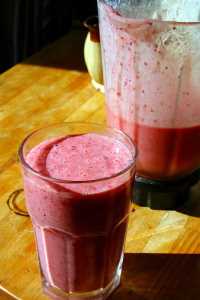How To Make a Healthy Smoothie
Published in IMPACT Magazine1
The Anatomy of a Healthy Smoothie
 The smoothie is a drink usually made by blending a variety of healthy ingredients into a refreshing snack or liquid meal.
The smoothie is a drink usually made by blending a variety of healthy ingredients into a refreshing snack or liquid meal.
Many people have their favourite combinations of fruit (fresh, frozen, or dried), yogurt, ice-cream, soy beverage, nuts and seeds, milk, green tea and even alcohol.
The latest trend has been for Green Smoothies which are usually “healthy”, but most are protein deficient and I always emphasize that “Green is not a nutrient”.
Some more unusual recipes include blending dry cereal, large flake rolled oats (dry), tofu, cooked rice and even energy bars into the mix.
The smoothie has healthy connotations, and considering the typical ingredients, the connotation should be correct for the most part. I certainly regard the smoothie as a better alternative to juicing because the entire fruit is eaten.
There is actually a book exclusively covering the history of the smoothie. We should realize that before we could produce a smoothie the blender had to be invented and of course there had to be a reliable source of electricity.
In other words, the history of smoothies is rather recent. It would have been impossible to use my grandmother’s manual eggbeater to produce similar results.
With the wide range and favoured choices of ingredients, most smoothies should be healthy. However there are some serious, usually ignored, considerations to make the smoothie healthy.
I reviewed about 100 smoothie recipes and found the following common health mistakes.
- Little attention is paid to the glycemic index/load of the ingredients. High glycemic index means the drink will created an elevated insulin response that leads to fat storage, inflammatory conditions and elevated blood pressure.
- Most drinks are protein inadequate. Even those described as high-protein do not contain adequate protein. The carbohydrate to protein ratio is too high, creating the same problems as in No. 1.
- The calorie count of most smoothies is considerable. I didn’t find one recipe below 300 calories and many exceeded 600. That means they are large snacks or even small to medium sized meals.
- The quality of the ingredients will determine the health value of the drink. A large issue with fruit and vegetables is the organic versus conventional sources. EWG (Environmental Work Group) publishes a list of the pesticide residue levels (up to 60 different pesticides on a single crop) on 53 common fruits and vegetables. It is disturbing to know the top of the contaminated list includes apples, celery, strawberries, peaches, nectarines and grapes. 2, 3
So to get the most out of your smoothie, here’s how to make a healthy, low glycemic smoothies
- Choose low Glycemic index fruits (apples and berries are best) and measure the serving sizes (1/2 cup of raspberries = 30 calories)
- To increase the protein content try including tofu (tasteless) cottage cheese, goat yogurt — plain has an excellent carb to protein ratio, as does organic yogurt — or add protein supplement powder. Do not use flavoured yogurt. It’s too high in sugar. You can even add a soft poached egg.
- Do some arithmetic on your ingredients so you know the calorie count.
- Milk (whole full fat) or Organic Soy Beverage are often the best base liquid for a nutritious smoothie. Adds 8-9 gm of protein.
- Ideally, choose organic, otherwise choose the least contaminated sources, such as Kiwi (rank 40), cantaloupe (rank 39), mango (rank 43 but high glycemic index) pineapple (rank 49 but also high glycemic index).
Low glycemic smoothie recipes
Snack Smoothie
- 1 cup Whole Milk or Organic Soy Beverage
- 1/2 cup raspberries
- 1/2 fresh peach
- 1 soft poached egg
- 3 tbsp soy protein supplement (15g protein, 9g carbs)
- 2 tbsp frozen orange juice
- 1/4 tsp vanilla extract
- Combine ingredients and blend.
- Calories 380, Protein 30g, Carbs 38 gm
Breakfast Smoothie
- 1/2 cup goat yogurt (plain)
- 1 kiwi (skin is very edible)
- 1 cup whole milk (or organic soy beverage)
- 1/4 mango
- 3 tbsp soy protein supplement (15g protein, 9g carbs)
- Combine ingredients and blend.
- Calories 395, Protein 31g, Carbs 50g
References
- Coyne, Impact Magazine, The Anatomy of a Healthy Smoothie, 2011, Sept./Oct., pp 96-97. IMPACT Magazine is Canada's premium health and fitness magazine.
- Pesticides in fruits and vegetables: www.ewg.org/foodnews
- 2017 Dirty Dozen - Shopper’s Guide to Pesticides in Produce ranks pesticide contamination on 48 popular fruits and vegetables.
Further Reading
Smoothies and fruit juices - a new risk to health, US scientists warn